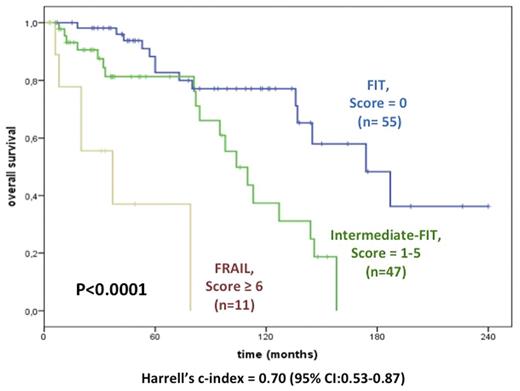Abstract
BACKGROUND: Clinical outcome of patients with chronic lymphocytic leukemia (CLL) is often poor due to the high prevalence of comorbidities as well as functional impairment that characterize this population. However, a consensus on the definition and measurement of frailty is lacking.
The present analysis was designed with the aim to develop a simple and easily applicable frailty score to predict overall survival.
PATIENTS: On a retrospective basis, a geriatric assessment (GA) has been performed in 113 CLL patients older than 65 years firstly diagnosed after January 2000 at our institution. GA included the Katz Activity of Daily Living (ADL), the Lawton Instrumental Activity of Daily Living (IADL) and the Cumulative Illness Rating Scale (CIRS).
Median age of patients was 71 years (range,65-90) and 32.7% were older than 75 years. According to the Rai staging system 48 (42.4%) patients were in stage 0, 47 (41.6%) in stage I-II and 18 (16%)in stage III-IV. Eighteen patients (16%) had a CIRS score higher than 6, 17 (15%) an ADL score lower than 5 and 21 (18.5%) an IADL score lower than 6.
RESULTS: After a median follow-up time of 66 months (range,3-330) 29 (25,6%) out of 113 patients have died and 58 (51.3%) received therapy (i.e., 24 at the diagnosis and 34 after a median follow-up time of 29 months [range, 6-136 months]).
Advanced age (HR=3.40), functional decline on ADL (HR=2.90) and IADL (HR=2.70), presence of comorbidities as assessed by CIRS score (HR=2.09), ECOG performance status (HR=4.94) and Rai clinical staging (stage 0 vs I-II, HR=3.65; stage 0 vs III-IV, HR=9.09) were all variables significant in univariate analysis. In a multivariate analysis which did not included Rai clinical staging a higher risk of death was observed for patients older than 75 years (HR=3.11; 95% CI, 1.60-6.06; P=0.001), with ADL lower than 5 (HR 3.50; 95% CI: 1.50-8.40; P=0.02) and CIRS higher than 4 (HR=2.09; 95% CI,1.08-4.05;P=0.03).
An additive frailty score based on the integer part of HRs (i.e., 1 point for HR 1.1-1.9; 2 points for HR 2.0-2.9) was then calculated. By combining the risk scores (range, 0-8) for these variables, patients were stratified according to a cutoff finder analysis into 3 distinctive risk groups for overall survival : fit (score = 0, 53,3%), intermediate-fit (score=1-5; 41.5%) and frail (score= 6-8,10%). Median overall survival of patients belonging to fit, intermediate-fit and frail group was as follows: fit, 174 months [95% CI:126-222]; intermediate-fit, 104 months [95% CI:82-127]; frail, 37 months [95% CI:3-71] (P<0.0001)(Fig. 1). The predictive accuracy of our score using Harrell c-index was 0.70 (95% CI:0.53-0.87). Finally, in a head-to-head comparison with Rai clinical staging, by Cox multivariate analysis, our frailty score retained its prognostic significance (fit vs intermediate-fit, HR,3.41 [95% CI,1.63-7.15], P=0.001; fit vs frail, HR, 12.06 [95% CI,3.33-43.67], P<0.0001).
CONCLUSIONS: This study represents the first attempt to develop an additive scoring system for CLL based on functional status, comorbidities and age. GA is a sensitive predictor of clinical outcome and could be used for selecting patients to treat with novel therapies.
Molica:Gilead Sciences: Speakers Bureau; Roche Italy: Membership on an entity's Board of Directors or advisory committees; Abbvie: Membership on an entity's Board of Directors or advisory committees; Jansen: Membership on an entity's Board of Directors or advisory committees.
Author notes
Asterisk with author names denotes non-ASH members.


This feature is available to Subscribers Only
Sign In or Create an Account Close Modal